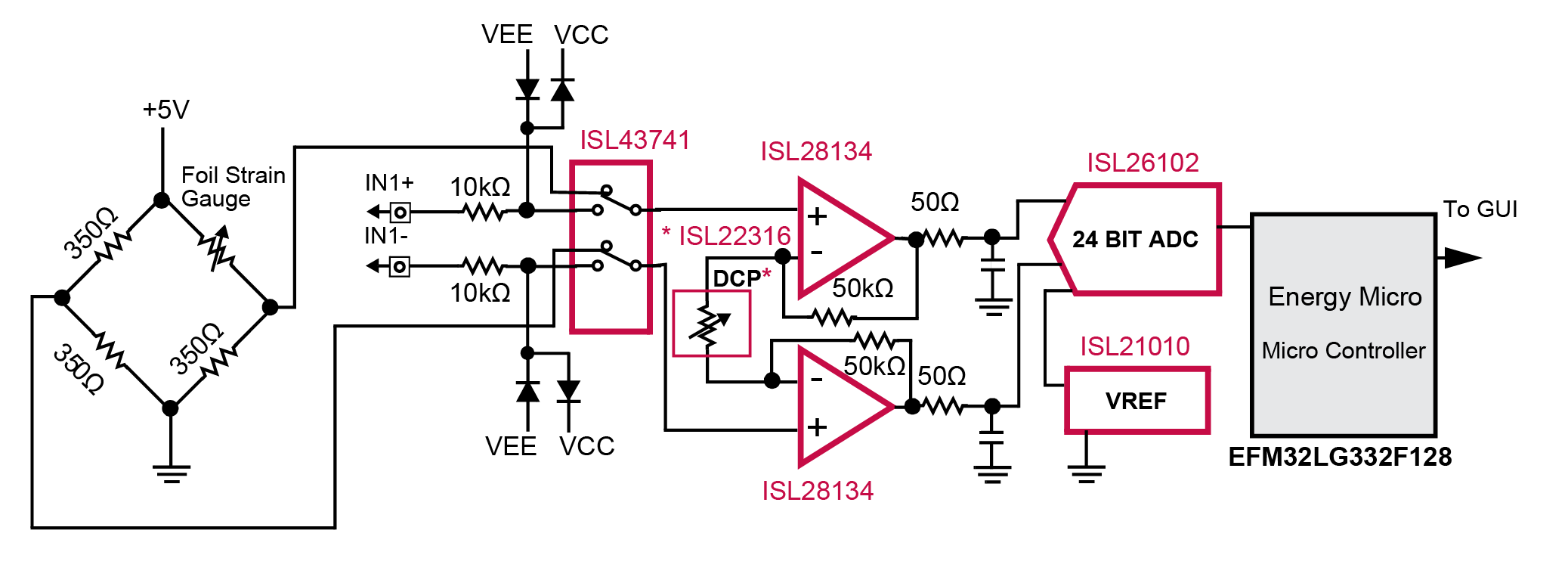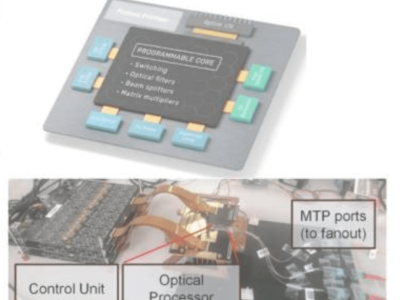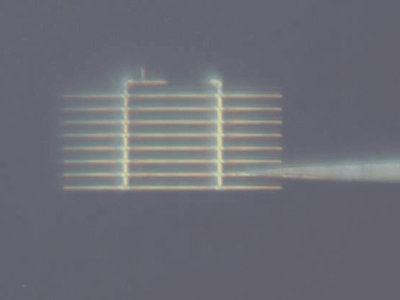
High accuracy analog signal measurement with ultra low power MCU
While identifying suitable customers in existing as well as new or emerging markets Avnet Memec analyzes the challenges that will be experienced by designers. There are many design considerations when optimizing a high precision analog design for low power consumption.
The solution we consider here with low power microcontrollers (MCU) assumes that the design aim is to achieve the best low noise precision for 16-bit to 24-bit applications focused on sensor and data acquisition. Typical applications for sensors include thermocouple or thermopile sensors and bridge sensors such as pressure, strain, flow, AMR and ultrasonic sensors. Of course, these applications can be used for general purpose analog inputs in data acquisition systems as well.
All of the solutions in the design we consider here achieve 18-bit to 22-bit ENOB (noise free bit design) are notable for highest precision. The solutions system partition for signal conditioning includes the frontend gain stage (usually amplifiers or instrumentation amplifiers), ADC and precision voltage excitation or voltage references for ratiometric design.

Intersil’s key mixed signal analog components for highest precision,
low noise design
Starting with the op-amp; biasing circuitry, input, output and compensation stages need to be examined.
The DC biasing circuitry for the op-amp must provide accurately determined and suitably regulated quiescent biasing currents at very low current levels. The current must be insensitive to changes in temperature, supply voltage and process tolerances. The configuration of the input stage will dictate whether the op-amp can be used in a single low voltage (1.2 V, or lower) supply application. Very low power supply operation using core devices is desirable (but not always possible). Using a Class B or AB output stage can reduce the quiescent power dissipation particularly in a leaky process.
Utilizing products with Rail to Rail common Mode input range but with the capability to drive a small output load can be desirable to achieve lower power consumption. But of course we still need to consider maintaining the high precision, accuracy and keeping offsets low with high input impedance is imperative while managing a high CMRR (Common Mode Rejection Ration) and PSRR (Power Supply Rejection Ratio). These are just some of the main considerations for the op-amp but there are of course a number of components required in a high precision signal chain one of the most important being the ADC. Higher throughput requires higher power consumption.
Reducing Sample Rates will reduce power consumption, which can potentially reduce the precision capabilities of the circuit design. With suitable conditioning and buffering an optimum performance can still be achieved while continuing to manage power efficiency effectively.
Choosing individual analog components including the ADC, op-amp, buffers and voltage regulators that work at lower supply voltages is a major consideration when optimizing your design for reduced power consumption.
If you require your design to work in a hand held application an obvious advantage here is to use batteries, which produce less noise than standard power supplies.
Immediately your analog signal path will have less interference from environmental and electrical disturbances. Also use of differential signal conditioning where possible can reduce noise in the design and also increase the dynamic range prior to ADC conversion.
The combination of the Intersil ISL28134 in differential configuration with the ISL26102 makes for one of the best implementations of precision, low noise design common in bridge sensor and data acquisition applications.
The components chosen for the reference design are chopper stabilized op amplifiers, the ISL28134; and the Delta Sigma ADC, ISL26102/104. The data acquisition solution shows ‘DAQ on Stick’ as an example. The solution employs the techniques mentioned previously to achieve lowest noise design for precision applications.
The ‘DAQ on Stick’ evaluation platform includes GUI software to select gain for various sensors including pressure, strain, flow, AMR and Ultrasonic sensors. Included in the demo is a Strain Gauge sensor (using Vishay’s VPG precision resistors). Additional circuitry is used to be able to attach various sensors and to allow for gain selection. These components are optional and can be removed for more optimal design if necessary.

DAQ on a stick with strain gauge

The Intersil ISL28134 Chopper Stabilized Op Amp uses state of the art CMOS design techniques to achieve extremely offset drift and low noise at moderate current levels.
The complex input circuits needed for rail to rail operation often increase both the noise level and the current consumption of an operational amplifier. In the ISL28134, this supply current overhead is minimal and the multiple input devices are exploited to achieve the 8 nV/rt(Hz) input noise level. Low power design throughout the amplifier keeps the total supply current down to 675 microamps (typical). The power can be reduced further to 1.7 mW by operating at 2.5 V supply. The advantage of the chopper stabilized design of the ISL28134 is the near-absence of flicker noise. In low noise, very low frequency applications the total noise is usually dominated by 1/f noise. However in the ISL28134 chopper stabilization is extensively applied, giving a 1/f noise corner of 0.005 Hz (see Figure 2).
The fact that the plot shows 12 nV/√Hz at 0.001 Hz (1000 seconds) shows the stability of the low offset design and performance. The actual data collection for this plot was taken over several hours, so this number at 0.001 Hz says the offset is very stable. The ISL28134 is one of the best ‘zero drift offset’ op amps in the industry today. Moreover, the ISL26102 Delta Sigma Converter also uses chopping techniques to remove 1/f noise and DC errors, preserving the unique 1/f noise performance of the ISL28134. Consequently, the combination of the ISL28134 in differential configuration into the ISL26102 makes for one of the best implementations for precision, low noise design common in bridge sensor and data acquisition applications.
Normally, the data acquisition system designer would be concerned with the chopping frequencies of the two ICs beating together, and would need to synchronize the chopping clock frequencies, or add extra filtering to remove the spurious outputs from the op. amp. None of this complexity is necessary with the ISL28134. A patented filter design reduces the chopping frequency spurious outputs to below the output noise level.

Figure 2:
The plot shows the 1/f corner for the ISL28134 at the
design parameter of 0.005 Hz
Now let’s explore possibilities for data acquisition with low power microcontrollers. In order to achieve low power consumption with microcontrollers, techniques can be applied to periodically sample the sensor or data acquisition inputs. The newer microcontrollers have new provisions to allow for lower power sampling modes for peripheral devices to operate while the microcontroller is in lower power status (see Table 2).
Modern microcontrollers have additional functions to allow various low power operation modes for external circuits while the microcontroller operates in lowest power modes; for example 0.6 uA of stop or standby current or if single step data transfer is used as low as 45 uA/MHz. Hence this sets the stage to develop periodic sampling techniques of higher power analog frontend components to reduce power consumption between active and standby modes. For example, the ISL28134 can be left in active mode as low as 1.7 mW (at 2.5 V) while the ISL26102 is at 10 μW in standby mode. This technique would allow for a faster and safer response for sensor sampling at lowest power levels and routines can be developed in conjunction of the microcontrollers for independent peripheral operations whilst in lowest power modes.

Table 2:
Examples of new modern functions of low power microcontrollers
Combining the low-power capabilities of the Renesas RL78 MCUs and Energy Micro’s Ultra Low Power EFM32 with Intersil’s high-precision analog expertise provides customers with a complete solution to help bring low power hand help applications to market quickly and efficiently. The new AFE-MCU solution is targeted toward industrial, medical and data acquisition applications. Each includes a sensor, signal conditioning circuits, and a microcontroller.
Avnet Memec has created a technology design support webpage for low power data acquisition solutions where you will find application notes, product data sheets and cook books providing much of the information you may need to support your design activities. Visit: www.avnet-memec.eu/products/newsletter/intersil/intersil-issue-september2013-low-power-precision-analog.html
 If you enjoyed this article, you will like the following ones: don't miss them by subscribing to :
eeNews on Google News
If you enjoyed this article, you will like the following ones: don't miss them by subscribing to :
eeNews on Google News




